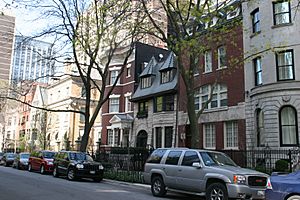Astor Street District facts for kids
The Astor Street District is a special area in Central Chicago, Illinois. It's known for its beautiful old buildings. Many of these homes were built over 100 years ago. They show off the fancy styles that rich families liked back then. You'll see old houses mixed with apartment buildings and townhouses.
This district was officially named a Chicago Landmark on December 19, 1975. This means it's a very important place in Chicago's history.
Contents
History of Astor Street
How Astor Street Began
Astor Street is named after a very rich man named John Jacob Astor. He never lived in Chicago, but the street was named to honor him. He was one of the wealthiest people in the United States. He made his money from the American Fur Company and by investing in land in New York City. His name made the area sound important and fancy.
Early Chicago Families Move In
Potter Palmer was one of the first big landowners in this neighborhood. At first, many rich Chicago families lived in huge houses on Prairie Avenue. But Palmer started buying land on the north side of the city. This area was not very crowded and was still a bit swampy after the Great Chicago Fire in 1871.
Interest in the area grew when Lake Shore Drive opened in 1875. This new road went along the lakefront. Going for a ride along the lake became a popular Sunday activity. By 1882, the Palmers started building one of the first huge houses on Lake Shore Drive. Their Gothic-style castle became the center of Chicago's high society. Bertha Palmer, Potter's wife, filled their home with many Impressionist paintings. This helped make these artworks popular and later formed a big part of the Art Institute's collection.
More Wealthy Residents Arrive
Other rich Chicago families soon followed the Palmers. People who made money from lumber, iron, and other businesses moved to the area. They built very grand homes. Some famous residents included:
- Kenneth Sawyer Goodman, a playwright. The Goodman Theatre is named after him.
- Robert Todd Lincoln, who was the only child of Abraham and Mary Todd Lincoln to live to adulthood.
- Albert F. Madlener, a successful businessman. His home now houses the Graham Foundation, which supports arts and architecture.
Within 20 years of Lake Shore Drive opening, Astor Street was fully developed. It was filled with city houses built close together. Because there wasn't much land, tall apartment buildings also became popular in the neighborhood.
Astor Street Architecture
The houses in the Astor Street District show different building styles. The main styles you'll see are Queen Anne, Richardsonian Romanesque, and Georgian Revival.
James Charnley House
The James Charnley House, also called the Charnley–Persky House, is a very important building in this historic area. It was designed in 1882 by a famous architect named Louis Sullivan. What makes it extra special is that a young Frank Lloyd Wright also worked on the project. He was just starting his career in Sullivan's office.
The house has a simple brick outside, but its decorations are very unique. Inside, it is beautifully decorated in Sullivan's special style. Today, the home is where the Society of Architectural Historians is located. They even offer walking tours of the house.
This home is a National Historic Landmark, which means it's very important to the whole country. It's also on the National Register of Historic Places and is a Chicago Landmark.
George Swift Isham Home
This large house at 1340 N State Parkway was built in 1899 for a surgeon, Dr. George Swift Isham. It has 70 rooms and is made of brick and limestone. The building became well-known when it was bought in 1959. Later, it was used as a dormitory for the School of the Art Institute.
In 1993, the mansion was sold. It was then changed into four very expensive luxury apartments. In 2011, one of these large apartments was put up for sale for $6.7 million.
Three Arts Club
The Three Arts Club of Chicago clubhouse was built in 1914. Its purpose was to provide a safe place for young women who were studying music, drama, or painting to live. This was part of a trend to build places for artists around that time. It showed that people were starting to appreciate the arts more in cities.
The building has 110 rooms. These rooms are built around a central courtyard. The entrance has a Byzantine style with colorful mosaics. These mosaics show the three arts: music, drama, and painting.
This building is also a Chicago Landmark.


